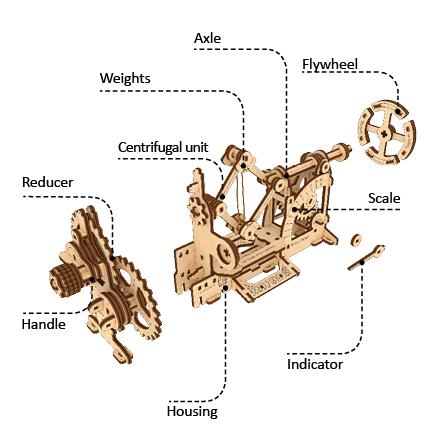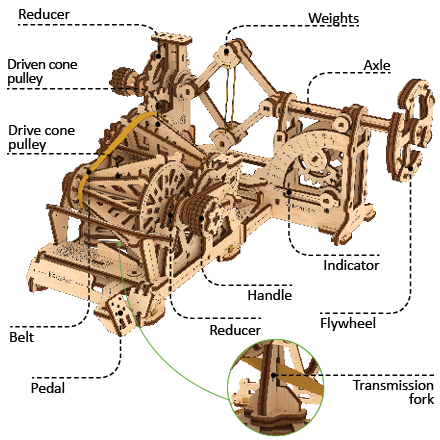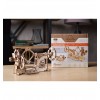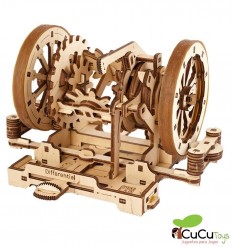No products
Prices are tax included
UGears - STEM Lab Tachometer, 3D wooden kit

CCT21UG70153
Warning: Last items in stock!
New
A tachometer (also known as a revolution counter) is a device that measures the rotational speed of different parts in engines or other mechanisms. Its measurements are made in revolutions per minute (RPM). The tachometer also measures and monitors the load limits to reduce or increase the RPM, so that the engine or mechanism operates within its optimum parameters.
Number of parts: 117.
Difficulty: Easy.
Assembly time: 2.5 hours.
Recommended age: 8-10 years.
Box dimensions: 20.5 x 18.8 x 6.3 cm.
Model dimensions: 24 x 10.3 x 12.3 cm.
Only for shipping to Spain & Portugal mainland

Añádelo al carrito y llévate 518 Cucus al comprar este artículo.
More info
Assemble the Tachometer and discover how it works.
- The model kit comes with a QR-code to the study guide about the mechanism, the principal of its working, the main characteristics, formulas. It also includes interesting assignments.
- Dive into augmented reality and look at how the Tachometer works. Interact with the model via a special AR application from Ugears.
Learn how the Tachometer works
A tachometer is a device designed to measure the rotational speed of various parts in engines and other mechanisms. It calculates revolutions per minute (RPM). The tachometer also measures and monitors load limits, in order to decrease or increase RPM so that the engine or mechanism runs within its optimal parameters.
Who invented the Tachometer, and when?
The tachometer was invented by the German engineer Dietrich Uhlhorn in 1817. His invention was a special device that measured centrifugal force. From 1840 on, this device has been used in railway locomotives, and later in cars and all manner of vehicular transport.
Use
The tachometer is used in mechanisms where it is necessary to accurately track RPM to avoid the negative consequences of overloads. Savvy motorists use tachometers to know when to shift gears (in cars with manual transmissions) and to control the load on the engine, thereby increasing the operating life of their vehicles.
What the Tachometer consists of and how it works
The Tachometer 3D puzzle from UGEARS' STEM Lab collection is a fully operational DIY wooden model of a tachometer, ready for you to assemble. When the handle is rotated, movement is transmitted through a reducer, increasing the RPM and displacing twin weights in the centrifugal unit. The higher the RPM, the more centrifugal force separates the weights, shifting a movable axle with flywheel. A pointer mechanism (dial) is fixed to the axle; the more the axle shifts (higher RPM), the more the dial arrow deflects, indicating higher speed rotation.
 |
The Tachometer mechanism consists of:
|
Connect the Tachometer to the Variator, creating a new mechanism
The Variator-Tachometer system demonstrates the direct relationship between the transmission ratio of a gearbox, and rotational speed.
When the handle of the Variator is rotated, the movement is transmitted through the reducer to the cone-shaped driving pulley. The rotation of the first cone is then transmitted through the belt to the other cone, which is the driven pulley. When the pedal attached to the housing is pressed, it shifts the fork holding the belt, thereby changing the rotational speed of the driven pulley. When the Tachometer is attached to the Variator, the changing rotational speed of the driven pulley of the Variator is transmitted to the Tachometer's reducer. This in turn will increase or decrease the centrifugal force on the weights, shifting the axle with flywheel. Shifting the axle deflects the indicator on the dial toward a higher or lower value. In this way, changes to the transmission ratio in the Variator will be seen to increase or decrease the RPM of the attached Tachometer.
 |
The Variator-Tachometer
|
Ugears STEM puzzles are designed to suit different age groups with a special focus on learning component. The assembly of the model will be interesting and won’t take much time.
|
STEM lab Model kits come with all you need in a box. Just like the rest of Ugears wooden model kits, putting STEM Lab models together is fun and comprehensive: everything you need to build, learn, and discover comes in a box. There you will find:
|

This product includes CE marking in accordance with European legislation.
Warnings
Remove all items from the packaging before giving the toy to the child.
Small parts risk of suffocation.
Not suitable for children under 3 years of age.
FAQ
What is STEM?
STEM, a term often used today, means Science, Technology, Engineering and Mathematics (for its abbreviations in English). And the reason for its pervasiveness is that it is an important part of the teaching curriculum. In practice, this means that educators set aside individual disciplines and adopt an approach based on skills and projects. In other words, it means making learning more interesting and attractive.Models for children and adults?
The models in this range are adapted to the age of the user. They are an understandable way to study widely used mechanisms, transmission and coupling systems as well as their practical applications in real life. Each Ugears STEM-lab model is developed to serve as a practical guide for teaching mechanics and physics to students between the ages of 8 and 14. They are also suitable for family activities applying STEM studies. Explaining things to a child using a Ugears STEM-lab model as a case study strengthens the bonds you have with your children. By moving through the different stages of the Ugears STEM project step by step, you will get to know different mechanisms in depth - literally. And as a result, what seemed like unexplainable mechanical magic becomes evident and understandable. As with the rest of the Ugears collections, the assembly of the STEM-lab models is fun and comprehensive: everything needed for assembly, learning and discovery is in the box .Why STEM educational toys?
The new range of Ugears models adopts the name STEM and its main concept. With each model, you get the toolkit for a STEM project and a challenge to meet. You will receive everything you need in the box and you only have to decide who you want to invite to be part of your project team: your parents, siblings or friends. Each of the mechanical models in the STEM-lab collection is an interactive study tool for a mechanism. Assembling them with your own hands will help you to understand perfectly the principles of their operation. Extend your learning experience even further with the Ugears augmented reality application. Photograph a fully assembled STEM-lab model with your tablet camera or mobile phone and the app will show you various uses of the mechanism you have just built. You will see how it is used in machines, buildings and industrial constructions. Explore it from different angles, get a close-up and an overview.Gift suggestions
The Ugears STEM-lab mechanical wooden models are great original gifts for any occasion and practical STEM projects for children and adults of all ages. Make your learning experience even more fascinating; discover how smart you are and how creative you can be. Give the best of yourself to children, teaching them essential mechanical, mathematical and engineering skills and say you are proud of them.All natural material
Made of ecological wood from sustainable sources, all Ugears STEM-lab models are easy to assemble without the use of glue or special tools thanks to our patented plywood joints. You will work with a natural material that is pleasant to the touch. The high quality plywood used is durable enough, but replacements may be needed. We have added individual parts in each box, however, if you need additional parts, please email us at [email protected] and we will send them to you by post free of charge.What is STEM?
STEM, a term often used today, means Science, Technology, Engineering and Mathematics (for its abbreviations in English). And the reason for its pervasiveness is that it is an important part of the teaching curriculum. In practice, this means that educators set aside individual disciplines and adopt an approach based on skills and projects. In other words, it means making learning more interesting and attractive.Models for children and adults?
The models in this range are adapted to the age of the user. They are an understandable way to study widely used mechanisms, transmission and coupling systems as well as their practical applications in real life. Each Ugears STEM-lab model is developed to serve as a practical guide for teaching mechanics and physics to students between the ages of 8 and 14. They are also suitable for family activities applying STEM studies. Explaining things to a child using a Ugears STEM-lab model as a case study strengthens the bonds you have with your children. By moving through the different stages of the Ugears STEM project step by step, you will get to know different mechanisms in depth - literally. And as a result, what seemed like unexplainable mechanical magic becomes evident and understandable. As with the rest of the Ugears collections, the assembly of the STEM-lab models is fun and comprehensive: everything needed for assembly, learning and discovery is in the box .Why STEM educational toys?
The new range of Ugears models adopts the name STEM and its main concept. With each model, you get the toolkit for a STEM project and a challenge to meet. You will receive everything you need in the box and you only have to decide who you want to invite to be part of your project team: your parents, siblings or friends. Each of the mechanical models in the STEM-lab collection is an interactive study tool for a mechanism. Assembling them with your own hands will help you to understand perfectly the principles of their operation. Extend your learning experience even further with the Ugears augmented reality application. Photograph a fully assembled STEM-lab model with your tablet camera or mobile phone and the app will show you various uses of the mechanism you have just built. You will see how it is used in machines, buildings and industrial constructions. Explore it from different angles, get a close-up and an overview.Gift suggestions
The Ugears STEM-lab mechanical wooden models are great original gifts for any occasion and practical STEM projects for children and adults of all ages. Make your learning experience even more fascinating; discover how smart you are and how creative you can be. Give the best of yourself to children, teaching them essential mechanical, mathematical and engineering skills and say you are proud of them.All natural material
Made of ecological wood from sustainable sources, all Ugears STEM-lab models are easy to assemble without the use of glue or special tools thanks to our patented plywood joints. You will work with a natural material that is pleasant to the touch. The high quality plywood used is durable enough, but replacements may be needed. We have added individual parts in each box, however, if you need additional parts, please email us at [email protected] and we will send them to you by post free of charge.De esta misma marca...
























